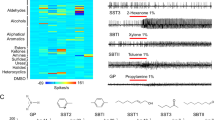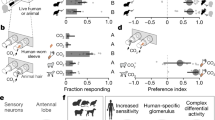Abstract
Female mosquitoes of some species are generalists and will blood-feed on a variety of vertebrate hosts, whereas others display marked host preference. Anopheles gambiae and Aedes aegypti have evolved a strong preference for humans, making them dangerously efficient vectors of malaria and Dengue haemorrhagic fever1. Specific host odours probably drive this strong preference because other attractive cues, including body heat and exhaled carbon dioxide (CO2), are common to all warm-blooded hosts2,3. Insects sense odours via several chemosensory receptor families, including the odorant receptors (ORs), membrane proteins that form heteromeric odour-gated ion channels4,5 comprising a variable ligand-selective subunit and an obligate co-receptor called Orco (ref. 6). Here we use zinc-finger nucleases to generate targeted mutations in the orco gene of A. aegypti to examine the contribution of Orco and the odorant receptor pathway to mosquito host selection and sensitivity to the insect repellent DEET (N,N-diethyl-meta-toluamide). orco mutant olfactory sensory neurons have greatly reduced spontaneous activity and lack odour-evoked responses. Behaviourally, orco mutant mosquitoes have severely reduced attraction to honey, an odour cue related to floral nectar, and do not respond to human scent in the absence of CO2. However, in the presence of CO2, female orco mutant mosquitoes retain strong attraction to both human and animal hosts, but no longer strongly prefer humans. orco mutant females are attracted to human hosts even in the presence of DEET, but are repelled upon contact, indicating that olfactory- and contact-mediated effects of DEET are mechanistically distinct. We conclude that the odorant receptor pathway is crucial for an anthropophilic vector mosquito to discriminate human from non-human hosts and to be effectively repelled by volatile DEET.
This is a preview of subscription content, access via your institution
Access options
Subscribe to this journal
Receive 51 print issues and online access
$199.00 per year
only $3.90 per issue
Buy this article
- Purchase on Springer Link
- Instant access to full article PDF
Prices may be subject to local taxes which are calculated during checkout





Similar content being viewed by others
References
Besansky, N. J., Hill, C. A. & Costantini, C. No accounting for taste: host preference in malaria vectors. Trends Parasitol. 20, 249–251 (2004)
Skinner, W. A., Tong, H., Pearson, T., Strauss, W. & Maibach, H. Human sweat components attractive to mosquitoes. Nature 207, 661–662 (1965)
Takken, W. & Knols, B. G. Odor-mediated behavior of Afrotropical malaria mosquitoes. Annu. Rev. Entomol. 44, 131–157 (1999)
Sato, K. et al. Insect olfactory receptors are heteromeric ligand-gated ion channels. Nature 452, 1002–1006 (2008)
Wicher, D. et al. Drosophila odorant receptors are both ligand-gated and cyclic-nucleotide-activated cation channels. Nature 452, 1007–1011 (2008)
Vosshall, L. B. & Hansson, B. S. A unified nomenclature system for the insect olfactory co-receptor. Chem. Senses 36, 497–498 (2011)
Larsson, M. C. et al. Or83b encodes a broadly expressed odorant receptor essential for Drosophila olfaction. Neuron 43, 703–714 (2004)
Benton, R., Sachse, S., Michnick, S. W. & Vosshall, L. B. Atypical membrane topology and heteromeric function of Drosophila odorant receptors in vivo. PLoS Biol. 4, e20 (2006)
Bohbot, J. et al. Molecular characterization of the Aedes aegypti odorant receptor gene family. Insect Mol. Biol. 16, 525–537 (2007)
Kim, Y. G., Cha, J. & Chandrasegaran, S. Hybrid restriction enzymes: zinc finger fusions to Fok I cleavage domain. Proc. Natl Acad. Sci. USA 93, 1156–1160 (1996)
Rémy, S. et al. Zinc-finger nucleases: a powerful tool for genetic engineering of animals. Transgenic Res. 19, 363–371 (2010)
Geurts, A. M. et al. Knockout rats via embryo microinjection of zinc-finger nucleases. Science 325, 433 (2009)
Grant, A. J. & Dickens, J. C. Functional characterization of the octenol receptor neuron on the maxillary palps of the yellow fever mosquito, Aedes aegypti. PLoS ONE 6, e21785 (2011)
Bohbot, J. D. & Dickens, J. C. Characterization of an enantioselective odorant receptor in the yellow fever mosquito Aedes aegypti. PLoS ONE 4, e7032 (2009)
Lu, T. et al. Odor coding in the maxillary palp of the malaria vector mosquito Anopheles gambiae. Curr. Biol. 17, 1533–1544 (2007)
Jones, W. D., Cayirlioglu, P., Kadow, I. G. & Vosshall, L. B. Two chemosensory receptors together mediate carbon dioxide detection in Drosophila. Nature 445, 86–90 (2007)
Ghaninia, M., Ignell, R. & Hansson, B. S. Functional classification and central nervous projections of olfactory receptor neurons housed in antennal trichoid sensilla of female yellow fever mosquitoes, Aedes aegypti. Eur. J. Neurosci. 26, 1611–1623 (2007)
Gouck, H. K. Host preferences of various strains of Aedes aegypti and Aedes simpsoni as determined by an olfactometer. Bull. World Health Organ. 47, 680–683 (1972)
Foster, W. A. & Takken, W. Nectar-related vs. human-related volatiles: behavioural response and choice by female and male Anopheles gambiae (Diptera: Culicidae) between emergence and first feeding. Bull. Entomol. Res. 94, 145–157 (2004)
Dogan, E. B., Ayres, J. W. & Rossignol, P. A. Behavioural mode of action of deet: inhibition of lactic acid attraction. Med. Vet. Entomol. 13, 97–100 (1999)
Ditzen, M., Pellegrino, M. & Vosshall, L. B. Insect odorant receptors are molecular targets of the insect repellent DEET. Science 319, 1838–1842 (2008)
Syed, Z. & Leal, W. S. Mosquitoes smell and avoid the insect repellent DEET. Proc. Natl Acad. Sci. USA 105, 13598–13603 (2008)
Liu, C. et al. Distinct olfactory signaling mechanisms in the malaria vector mosquito Anopheles gambiae. PLoS Biol. 8, e1000467 (2010)
Bohbot, J. D. & Dickens, J. C. Insect repellents: Modulators of mosquito odorant receptor activity. PLoS ONE 5, e12138 (2010)
Pellegrino, M., Steinbach, N., Stensmyr, M. C., Hansson, B. S. & Vosshall, L. B. A natural polymorphism alters odour and DEET sensitivity in an insect odorant receptor. Nature 478, 511–514 (2011)
Lee, Y., Kim, S. H. & Montell, C. Avoiding DEET through insect gustatory receptors. Neuron 67, 555–561 (2010)
Hallem, E. A. & Carlson, J. R. Coding of odors by a receptor repertoire. Cell 125, 143–160 (2006)
Carey, A. F., Wang, G., Su, C. Y., Zwiebel, L. J. & Carlson, J. R. Odorant reception in the malaria mosquito Anopheles gambiae. Nature 464, 66–71 (2010)
Silbering, A. F. et al. Complementary function and integrated wiring of the evolutionarily distinct Drosophila olfactory subsystems. J. Neurosci. 31, 13357–13375 (2011)
Acknowledgements
We thank K. J. Lee and members of the Vosshall lab for comments on the manuscript. F. Urnov of Sangamo BioSciences suggested the experiments in Supplementary Fig. 1. We thank C. McMeniman for initiating the A. aegypti GFP ZFN disruption project together with M.D. and for establishing mosquito microinjection at Genetic Services Inc. S. Dewell of the Rockefeller University Genomics Resource Center provided bioinformatic assistance. W. Takken and N. Verhulst suggested the use of nylon stockings in Figs 4 and 5. Román Corfas provided advice on imaging in Fig. 5b. This work was funded in part by a grant to R. Axel and L.B.V. from the Foundation for the National Institutes of Health through the Grand Challenges in Global Health Initiative. This work was supported in part by grants from the National Institutes of Health to C.S.M. (DC012069) and N.J. and A.A.J. (AI29746). L.B.V. is an investigator of the Howard Hughes Medical Institute.
Author information
Authors and Affiliations
Contributions
M.D. carried out the experiments in Fig. 1 and Supplementary Fig. 1 and Supplementary Fig 2b, c. E.J.D. carried out the experiments in Supplementary Fig. 2a. N.J. generated the GFP transgenic A. aegypti and injected the GFP ZFN for Supplementary Fig. 1 and was supervised by A.A.J. T.N. carried out the experiments in Fig. 2. C.G. reared mosquitoes and genotyped orco mutants. C.S.M. developed the assays used in Figs 3 and 4 with M.D. and L.S. L.S., M.D. and C.S.M. carried out the experiments in Figs 3 and 4. L.S., E.J.D. and M.D. developed and carried out the assays in Fig 5. M.D., C.S.M. and L.B.V. wrote the paper.
Corresponding author
Ethics declarations
Competing interests
The authors declare no competing financial interests.
Supplementary information
Supplementary Information
This file contains Supplementary Figures 1-3, Supplementary Methods and additional references. (PDF 1939 kb)
Aedes aegypti orco mutants are attracted to a DEET-treated human arm
Time-lapse 4 minute video of the human host proximity assay using a human arm treated with 10% DEET shown at 16x speed (see Fig. 5b). The video shows an introductory cartoon highlighting the human arm and the cage screen followed by a side-by-side view of one trial each of wild-type (left) and orco2/5 mutant (right) female mosquitoes. Video images were recorded in the same manner as for the experiments in Figure 5b, except at a rate of 1 frame per second. (MOV 14207 kb)
Rights and permissions
About this article
Cite this article
DeGennaro, M., McBride, C., Seeholzer, L. et al. orco mutant mosquitoes lose strong preference for humans and are not repelled by volatile DEET. Nature 498, 487–491 (2013). https://doi.org/10.1038/nature12206
Received:
Accepted:
Published:
Issue Date:
DOI: https://doi.org/10.1038/nature12206
This article is cited by
-
Hydrophobic solution functions as a multifaceted mosquito repellent by enhancing chemical transfer, altering object tracking, and forming aversive memory
Scientific Reports (2024)
-
Combinatorial encoding of odors in the mosquito antennal lobe
Nature Communications (2023)
-
AsOBP1 is required for host seeking in the malaria vector mosquito, Anopheles sinensis
Journal of Pest Science (2023)
-
Opsin1 regulates light-evoked avoidance behavior in Aedes albopictus
BMC Biology (2022)
-
Differentiation of action mechanisms between natural and synthetic repellents through neuronal electroantennogram and proteomic in Aedes aegypti (Diptera: Culicidae)
Scientific Reports (2022)
Comments
By submitting a comment you agree to abide by our Terms and Community Guidelines. If you find something abusive or that does not comply with our terms or guidelines please flag it as inappropriate.



